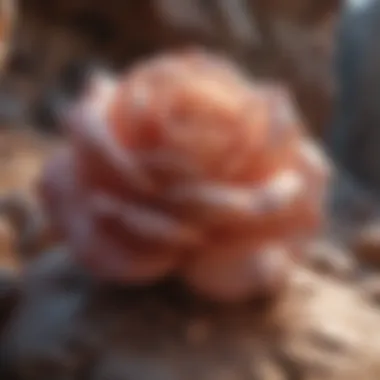Rocks That Look Like Roses: A Geological Exploration


Intro
Rocks that resemble roses are among the most striking examples of natural beauty. These formations, often called rose rocks or selenite roses, evoke a fascination that transcends mere aesthetic appeal. Understanding their formation and significance is imperative for both novice and experienced collectors. This guide will provide insights into the history, identification, and care of these exquisite specimens.
History and Origins
Overview of Collectibles, Rocks, and Fossils
The world of collectibles is rich and diverse, encompassing items that spark joy and interest. Among these, rocks and fossils hold a special place. Rose-like formations have captured the attention of many geologists and hobbyists alike. Their unique appearance makes them desirable in both artistic and scientific communities.
Rose rocks are typically composed of gypsum, a soft mineral that forms under specific conditions. Their delicate, petal-like structures arise from the evaporation of water in arid environments, exemplifying nature’s artistry in mineral formation. The historical context of collecting these unique geological specimens can be traced back to ancient civilizations that revered them for their beauty and purported protective qualities.
Historical Significance and Cultural Impact
Throughout history, rose rocks have held various meanings across cultures. For some, they symbolized love and prosperity, while for others, they served as talismans of protection. Ancient peoples often incorporated them into rituals or used them as decorative objects.
In the American Southwest, indigenous tribes recognized the significance of these peculiar formations, often associating them with storytelling and spirituality. In contemporary society, they continue to be a popular choice among collectors, geologists, and hobbyists, serving as a bridge between art and science.
Identification and Classification
Guide to Identifying Rocks and Fossils
Identifying rose-like rocks is not overly complicated but requires attention to detail. When observing a potential specimen, examine the following characteristics:
- Color: Most rose rocks display soft hues, ranging from cream to light brown.
- Texture: The petal-like formations should have a smooth texture.
- Structure: Look for a radial pattern that mimics floral shapes.
By understanding these identifiers, collectors can hone their ability to distinguish genuine specimens from lookalikes.
Common Types and Variations
While the term "rose rock" is often used broadly, there are several types worth noting:
- Gypsum Rose: This common variety is primarily found in Oklahoma, characterized by its multi-layered petals.
- Barite Rose: Less frequent than gypsum, these formations present a more crystalline appearance.
- Silica Rose: Composed largely of quartz, these specimens are rarer and often sought after.
Being aware of these variations can enrich a collector’s understanding and appreciation of these geological wonders. Collectors should take care to educate themselves further through resources like Wikipedia or Britannica for deeper insights.
"The phenomenon of rocks that resemble roses is not merely about geology; it intertwines with culture, history, and personal narratives."
In summary, exploring the phenomenon of rose-like rocks reveals a fascinating intersection of geology and culture. Understanding their origins, significance, and identification helps enhance appreciation and fosters a deeper connection with nature. As the article progresses, we will explore more aspects of these captivating formations.
Intro
The study of rose-like rocks presents a fascinating intersection of geology, aesthetics, and cultural significance. For both enthusiasts and dedicated collectors, understanding these unique formations is essential. These rocks, such as selenite and barite, evoke curiosity due to their intricate appearances resembling a flower. Such a phenomenon begs the question: what processes lead to this natural artistry?
This article aims to explore these intriguing geological formations in depth. It will delve into the scientific processes involved in creating these rocks, reveal the diverse types observable in nature, and explore the cultural meanings attributed to them across different societies. Knowledge in these areas not only enhances appreciation but also serves as a foundation for informed collecting decisions.
By examining the conditions under which rose-like rocks form, we can better appreciate their uniqueness. Collectors will find practical information on locating, identifying, and caring for these specimens. The intricacies of their composition, and the environmental factors that influence their creation, enrich our understanding of natural history as a whole.
Thus, this introduction sets the stage for an enlightening exploration that caters to both novice and seasoned collectors, while reinforcing the profound relevance of this topic in the context of geology and cultural appreciation.
Understanding the characteristics of rose-like rocks allows collectors not only to appreciate their beauty but also to contextualize their significance within the geological narrative.
Understanding Rose-like Rock Forms
Understanding rose-like rock forms is essential for both enthusiasts and collectors alike. These formations not only captivate the eye but also represent complex geological processes that have occurred over millions of years. By grasping the characteristics and formation of these rocks, collectors can better appreciate their intrinsic value and the story they tell about Earth's history.
The exploration involves recognizing how these stones differ from regular rocks. Their unique shapes and features can be attributed to specific mineral compositions and the environmental conditions they form under. This knowledge is not just academic; it enhances the collector's ability to identify true rose-like rocks from similar formations, ensuring that their collections are both diverse and scientifically valuable.
Furthermore, an understanding of these formations fosters a more responsible approach to collection. Knowing where and how these rocks form helps collectors understand their ecological significance and promotes ethical gathering practices. In essence, understanding rose-like rock forms lays the foundation for a more informed and conscientious community of collectors.
Definition of Rose-like Rocks
Rose-like rocks, often described as resembling blooming flowers, exhibit concentric patterns. They are typically characterized by a petal-like structure that forms due to the crystallization of specific minerals. Two of the most notable are selenite and barite, each renowned for their distinct appearance.
These formations often arise in sedimentary environments where conditions allow for mineral growth in plate-like formations. They can be found across various geographical regions, with each having its unique attributes depending on the local geology.
Geological Processes Involved
The geological processes that contribute to the formation of rose-like rocks entail several factors. Initially, the presence of the right mineral components is crucial. Selenite is a form of gypsum, while barite is a barium sulfate mineral. When conditions such as temperature and pressure fluctuate, these minerals can crystallize to form layered structures that mimic a blooming rose.


Additionally, the role of water is significant in this transformation. When mineral-laden water evaporates, it leaves behind deposits that can create the distinctive layering needed for rose-like formations. Factors like soil chemistry and local mineralization play critical roles as well. The result is a striking array of shapes and colors, showcasing the incredible diversity of nature's artistry.
"Rocks resembling roses are not just geological anomalies; they symbolize the intricate processes that shape our planet's surface."
In summary, understanding the definition and geological processes involved in the formation of rose-like rocks enriches the collector's knowledge base. It equips them with the tools to identify these stunning specimens with accuracy, ensuring a more robust collection that honors the natural world's complexity.
Types of Rocks That Resemble Roses
Understanding the types of rocks that resemble roses is essential for any collector or geologist interested in this unique phenomenon. Each type exhibits distinct characteristics and formation processes. Analyzing these varieties provides valuable insights into geological patterns and historical conditions that shaped them. This section delves into notable examples, highlighting their significance in terms of aesthetics, collector interest, and scientific inquiry.
Selenite Rose
Selenite roses are among the most recognized forms of rose-like rocks. This mineral consists of crystallized gypsum, featuring delicate, petal-like layers that make it particularly fascinating. The unique shape results from a specific set of environmental factors, mainly evaporation in saline environments. With its translucent quality, selenite can catch light beautifully, making it a sought-after specimen for display.
In terms of identification, selenite roses can be distinguished by their thin, flat crystals that radiate from a central point. Their softness, rated at 2 on the Mohs scale, requires careful handling to avoid scratching. Collectors appreciate selenite for its beauty and relative accessibility. These traits make it a primary target for beginners and seasoned collectors alike.
Barite Rose
Another significant example is the barite rose, which showcases a completely different mineral composition. Barite, or barium sulfate, forms in a process known as precipitation, often in marine environments. Barite roses display a robust structure, often appearing in clusters that resemble roses with their distinctly arranged blades. Their color varies from white to shades of brown, adding to their appeal.
Identification of barite roses can be straightforward due to their heavier weight—barite has a density of around 4.5. This characteristic distinguishes them from other rose-like rocks. The beauty and rarity of barite specimens, combined with their intriguing formation process, make them particularly attractive to collectors.
Other Varieties
Beyond selenite and barite, several other varieties of rocks exhibit a rose-like form. These can include minerals such as calcite and fluorite, which result from similar processes but have different chemical compositions. Each variety contributes to the understanding of geological diversity.
When encountering these other varieties, collectors might focus on factors such as:
- Color variations: Different mineral contents lead to unique hues.
- Size and formation: The conditions under which these rocks were formed can influence their overall appearance.
- Rarity: Some varieties may be less common, thus increasing their value and desirability among collectors.
In summary, recognizing and appreciating the different types of rocks that resemble roses enhances the overall collecting experience. Each specimen tells a part of Earth's geological history, enriching our understanding of how these formations occur.
Formation Conditions
Understanding the formation conditions of rocks that resemble roses is crucial for both collectors and geologists. These conditions dictate not only the shape and structure of the formations but also their distribution across different geographic locations. By exploring these factors, one can gain insight into how these unique geological structures come into existence and what makes them marvels of natural history.
Environmental Factors
The environmental factors contributing to the formation of rose-like rocks are multi-faceted. Temperature, humidity, and the presence of certain minerals play significant roles. For instance, many of these formations arise in arid environments, where evaporation rates are high. This high evaporation leads to the crystallization process, which is critical in forming the unique patterns seen in rocks like selenite roses and barite roses.
In addition to climate, the geological history of the area is equally essential. Sedimentary and evaporitic deposits create the right conditions for these formations. When conditions are favorable, mineral-rich waters may flow through rock layers, leading to crystallization that mimics rose-like structures. It's also worth noting that specific regions, such as parts of the southwestern United States, are more likely to exhibit these formations due to their unique environmental conditions and geological history.
Mineral Composition
The mineral composition of rocks resembling roses is another key aspect of their formation. Different minerals can create distinct appearances and properties in rose-like formations. For example, selenite, a form of gypsum, is known for its translucent quality and delicate appearance, making it a popular choice among collectors. Alternatively, barite rose demonstrates a more robust appearance characterized by its heavier density and unique crystal forms.
The combination of these mineral types influences not only the aesthetic of the rock but also its durability and market value. Understanding the specific minerals present in a sample can help collectors make informed decisions about their purchases. Each variety has its own unique attributes, which can either increase or decrease its desirability in the collector community.
Locating Rose-like Rocks
Finding rose-like rocks is an exciting journey for any collector. Understanding where these unique formations exist is vital. It allows enthusiasts to plan effective collecting trips. Moreover, it enhances your appreciation of these geological wonders.
Collecting rose-like rocks is not just about aesthetics. It's also about understanding the geological landscape. Knowing the regions where these formations thrive can increase your chances of successful collecting. Additionally, it provides context for their formation.
Regions of Interest
Rose-like rocks are located in specific geological settings. Various factors contribute to their presence. For example, sedimentary environments rich in gypsum often yield selenite roses. These are common in regions like Utah and New Mexico.
Barite roses, on the other hand, are more frequently found in places like Morocco. This highlights the importance of understanding local geology. Some other notable regions include:
- Midwest USA: Often yields unique varieties.
- Southern Spain: Known for both selenite and barite roses.
- Egypt: Home to beautiful specimens due to its unique desert conditions.
When searching for these rocks, it's also helpful to consult local mineral clubs or online forums. Often, experienced collectors share insights about lesser-known locations.
Collecting Techniques
Collecting rose-like rocks requires certain techniques to ensure success and safety. First, always conduct thorough research before visiting a location. Understanding the geological makeup is essential. This takes guesswork out of the equation.
When out in the field, several techniques can enhance your collecting experience:


- Use Basic Tools: A rock hammer and safety goggles are essential. They help in safely extracting specimens without damage.
- Patience is Key: Spend time looking through rubble piles. Sometimes the best specimens are hidden among lesser rocks.
- Respect Nature: Always follow legal guidelines and collect sustainably. It's important to leave some rocks for future collectors.
- Document Finds: Take pictures and notes of your locations. This could help in future endeavors.
Through proper research and specific collecting techniques, locating and collecting rose-like rocks can be a rewarding hobby. Understand the regions, employ effective collection techniques, and enjoy the process.
Identification and Valuation
Understanding the identification and valuation of rose-like rocks is essential for both collectors and enthusiasts. The ability to accurately identify these specimens allows collectors to appreciate the geological processes that formed them. Moreover, valuation plays a significant role in the market for such rocks, influencing purchasing decisions and ethical considerations in collecting. Collectors who are well-versed in these aspects can ensure they obtain genuine specimens while safeguarding their investments.
Criteria for Identification
Identifying rose-like rocks involves several key criteria. First, physical appearance is paramount. These rocks often exhibit layered structures resembling petals. A detailed examination of the rock’s texture, color, and formation layers can provide significant clues.
Second, mineral composition is crucial. Rose-like formations, such as selenite or barite roses, have distinct mineral properties. Analysing samples with a microscope can highlight specific crystal formations which aid in identification.
Third, geographical origin can also indicate the type of rose-like rock. Understanding the region where the rock was found can help determine its authenticity and potential value.
Lastly, consulting reference materials is beneficial. The use of guides and databases that catalog various rose-like rock types can help collectors refine their identification skills.
Market Values and Rarity
The market values of rose-like rocks fluctuate based on several factors. One of the primary factors is rarity. Some varieties, like the abundant barite rose, are commonly available, while others, such as certain selenite forms, might be considerably rarer. This scarcity can drive up demand and, consequently, price.
Another factor influencing value is size. Larger specimens, particularly those with well-preserved structures, tend to command higher prices.
Additionally, the overall condition of the rock plays a role in its valuation. Specimens that are well-maintained and free from damage often attract collectors willing to pay a premium.
"Accurate identification is not just a skill; it is essential for preserving the integrity of rock collecting."
For more information on geological characteristics of rocks, visit Wikipedia or Encyclopaedia Britannica.
Engaging in forums, such as Reddit, can also provide valuable insights from fellow collectors regarding market trends and valuation tips.
Cultural Significance
Understanding rose-like rocks goes beyond their geological formation. They occupy a unique niche in human history and culture. Throughout the ages, these formations have been appreciated not just for their beauty but also for the stories they tell. The significance of these rocks can be categorized into several key areas.
Historical Perspectives
Rose-like rocks like selenite and barite have been known to various cultures for centuries. In ancient times, their unique shapes sparked myths and legends. For example, in Egypt, selenite was considered a spiritual stone, linked to the moon. Historical texts suggest that it was used in rituals for its believed protective energies. Further, these stones have served as tools and decorative elements, showcasing their practical and aesthetic value.
Archaeological sites occasionally reveal these rocks among artifacts, underscoring their role in everyday life. In many cultures, these stones were thought to symbolize purity and rebirth. In using rose-like formations, early humans likely believed they could harness their perceived magical properties.
Symbolism in Various Cultures
The symbolism attached to rose-like rocks varies significantly across different cultures. In Western culture, the rose shape often evokes ideas of love and beauty. Collectors may look at these rocks not just as geological specimens but as tokens of nature's artistry. Here, the aesthetics are paramount.
In contrast, Eastern traditions might emphasize different attributes. For instance, in some Asian cultures, rose-like formations are believed to bring good fortune and prosperity. The delicate structure of a barite rose may serve as a reminder of balance in nature, urging individuals to seek harmony in life.
Moreover, the various colors and textures of these rocks also play a role in their symbolism. A pink selenite rose may represent compassion, while a darker hue could convey deeper emotions or resilience.
"Rocks are the memory of the Earth, each with its own story and significance."
These multifaceted meanings contribute to the appeal of collecting rose-like rocks. For enthusiasts, their cultural narratives enrich the collecting experience, making each specimen a conversation starter that transcends its geological roots.
Preserving Rose-like Rocks
Preserving rose-like rocks is a critical aspect of both geological study and enthusiast collecting. These rocks, notable for their unique appearance and formation processes, require thoughtful care to ensure longevity and maintain their aesthetic qualities. Proper preservation enhances the value of these specimens not only for personal enjoyment but also for educational and scientific purposes. Therefore, understanding the elements of care and handling as well as appropriate display techniques becomes necessary for collectors.
Scientific Study of Rose-like Rocks
The study of rose-like rocks is an essential facet of geology that not only reveals the intricate processes behind their formation but also highlights their significance in broader scientific contexts. Understanding these unique formations provides insights into various geological phenomena, which can lead to advancements in both academic research and practical applications.
Rose-like rocks, most famously selenite and barite roses, offer clues into ancient geological environments. They serve as time capsules, revealing critical aspects of the Earth’s past. By studying their formation conditions and mineral compositions, scientists can interpret past climatic conditions and geological events.
A comprehensive scientific study enables researchers to map the distribution of rose-like rocks, contributing significantly to regional geological surveys. Furthermore, the insights gathered can inform conservation efforts and guide collectors in ethical practices.
Paleontological Insights
Paleontology, the study of historical life forms through fossils, intersects intriguingly with the study of rose-like rocks. These rocks can encase microfossils and other remnants of past biological activity, providing a glimpse into the ecosystems that existed millions of years ago. For paleontologists, examining these formations can reveal information about how ancient organisms interacted with their environment, contributing to our understanding of evolutionary biology.


Additionally, certain rose-like rocks may point to specific fossil-bearing layers, indicating where more extensive fossil excavations could yield fruitful results.
In summary, the relationship between paleontological insights and rose-like rocks is a testament to the interconnectedness of geological and biological sciences. They serve not only as artistic geological formations but also as invaluable resources for historical and biological discovery.
Geological Surveys
Geological surveys play a vital role in cataloging and understanding the occurrences of rose-like rocks across various regions. By conducting systematic surveys, geologists can assess the prevalence of these formations and evaluate their mineralogical properties. Such surveys establish a framework for further research and can inform collectors about the best locations to find unique specimens.
Moreover, geological surveys facilitate the identification of environmental conditions conducive to the formation of these rocks. Factors such as evaporation rates, availability of minerals, and sediment conditions dictate where rose-like rocks can form. Through detailed geological surveys, scientists create predictive models that can assist in locating untapped deposits.
"The exploration of rose-like rocks not only enhances our understanding of geological processes but also connects us to the planet’s intricate history."
This integral knowledge benefits all who have an interest in geology, paleontology, and the broader implications of natural history.
Community Engagement
Community engagement is vital in the study and appreciation of rose-like rocks. It fosters a sense of belonging among collectors and enthusiasts while also enhancing knowledge exchange. Joining together, collectors share their experiences, techniques, and findings. This interaction can stimulate interest and deepen the understanding of geological processes involved in the formation of these unique structures.
Collecting Communities
Collecting communities provide a platform for enthusiasts of rose-like rocks to connect. These communities can be local clubs or online groups. They often host events, such as field trips, where members gather to explore specific locations known for these rocks. Through these activities, members learn about the geology in their region. They also discuss and compare their gathered specimens. Participation in such communities can be beneficial.
- Networking: Meeting other collectors can offer new perspectives and insights.
- Skill Development: Sharing techniques for identifying and collecting can enhance skills.
- Resource Sharing: Members frequently share books, articles, or websites that provide additional knowledge on rock formations.
Prominent platforms include:
- Facebook groups focused on mineral and fossil collecting.
- Reddit threads where users discuss their finds and techniques.
Online Forums and Resources
Online forums serve as entry points for collectors and researchers. They allow for the easy exchange of information across geographical barriers. Many rock and fossil communities maintain active discussions about specific topics, including rose-like rocks. Such forums provide access to expert opinions and advice on collecting practices, care methods, and preservation techniques.
Some significant online resources are:
- Wikipedia serves as a research tool for initial inquiries about geological concepts.
- Britannica offers comprehensive articles that can deepen one’s understanding of minerals and their properties.
Forums can be a useful stage for:
- Asking Questions: Collectors can seek guidance on identification.
- Showcasing Finds: Sharing discoveries strengthens community ties and builds engagement.
- Organizing Events: Members can collaboratively plan meetups or collecting trips.
Engagement with these communities not only enhances individual knowledge but also cultivates a collective appreciation for the fascinating phenomena represented by rose-like rocks. As interest grows, it results in a more robust exploration of their significance in both geological and cultural contexts.
Challenges in Collecting
Collecting rocks that resemble roses presents numerous challenges for enthusiasts. Understanding these hurdles is essential not just for improving collecting techniques but also for ensuring the sustainability of these unique geological specimens. This section highlights some significant legal, ethical, and environmental considerations related to the collection of rose-like rocks, shedding light on the responsibilities of collectors.
Legal and Ethical Considerations
The collection of rocks, coupled with the alluring nature of rose-like forms, invites legal complexities. Different regions impose specific regulations concerning rock collection. In many cases, permission is required from landowners or local authorities before any collecting can take place. Violating these regulations can lead to fines or potential legal action. Moreover, some areas, such as national parks, prohibit any collection altogether to protect natural heritage and biodiversity.
Ethical considerations also play a crucial role in rock collecting. It is vital for collectors to respect natural environments and engage in sustainable practices. Taking too many specimens from a single area can disrupt the local ecosystem. Therefore, collectors should prioritize responsible sourcing by ensuring their methods contribute positively to the local geology and flora.
When participating in local geology clubs or groups, collectors often discuss these legal and ethical aspects. They share experiences and resources that help newcomers navigate these complexities. Local forums and online resources can also provide guidance on best practices, emphasizing the significance of community in promoting responsibility.
Environmental Impact
The environmental impact of rock collecting is another consideration for any enthusiast. While the physical act of collecting might seem innocuous, it can lead to unintended consequences. The removal of rocks, especially in large quantities, can result in soil erosion, habitat destruction, and disrupt local wildlife. Furthermore, the aesthetic value of natural landscapes can suffer if too many stones are extracted from a single site.
Collectors must also be aware of the importance of leveraging environmentally sustainable methods. Here are some considerations for minimizing impact:
- Research Locations: Know the geology and ecology of an area before collecting.
- Limit Collection Numbers: Only take a few samples from abundant sites to mitigate disruption.
- Utilize Tools Wisely: Use non-invasive tools to prevent destruction of the surrounding environment.
Fostering awareness about these environmental impacts is crucial for preserving the natural beauty of Rose-like rock locations. By approaching rock collecting with care and consideration, collectors can help ensure that future generations enjoy these geological wonders as much as they do.
Ending
The exploration of rose-like rocks is not merely a scientific endeavor, but also an appreciation of nature's intricate designs. This article delves into various aspects of these fascinating formations. From understanding their geological processes to recognizing their cultural significance, each element contributes to a broader comprehension of these unique stones.
One vital aspect discussed is the detailed identification process for collectors. Knowing the criteria for distinguishing different types of rose-like rocks enhances not only collecting skills but also promotes responsible practices in the field. For example, understanding local laws and guidelines for collecting prevents potential issues that may arise from illegal harvesting.
There is also a clear benefit in recognizing the environmental impacts of collecting practices. Collectors should be made aware of how their actions can affect local ecosystems, ensuring we preserve the natural beauty and fragile conditions that allow these unique rocks to form. Promoting sustainable collecting is essential for future generations of enthusiasts.
Furthermore, the communal aspects cannot be overlooked. Online forums and collecting communities foster a sense of belonging among enthusiasts. These platforms allow for sharing knowledge, experiences, and resources, all contributing to a richer understanding of rose-like rocks. The exchange of ideas nurtures both new and seasoned collectors and strengthens connections within the community.
In summary, the conclusion of this investigation emphasizes that understanding rose-like rocks extends beyond simple curiosity. It equips collectors with essential knowledge, empowers them to make informed decisions, and enriches the shared community amongst rock and fossil collectors. Overall, the study of these unique rocks reflects a deep connection with nature, reinforcing a respect for the Earth’s many wonders.



